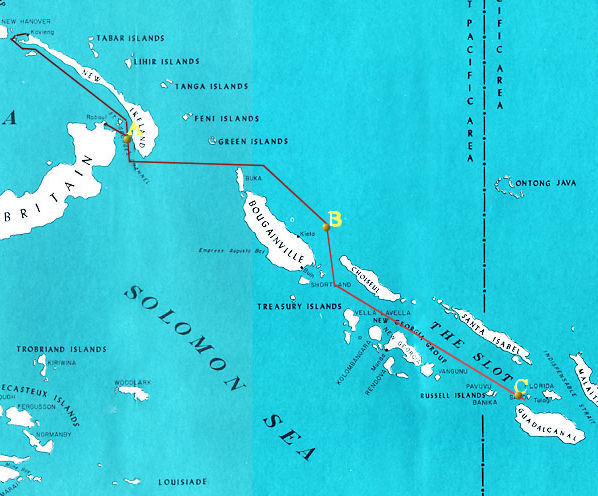
Japanese Admiral Mikawa, 8th Fleet Commander, quickly organized a counterattack. He departed Kavieng at the NW end of New Ireland the afternoon of August 7th with heavy cruisers Aoba, Furutaka, Kako and Kinugasa, joined near sunset by heavy cruiser Chokai, light cruisers Tenryu and Yubari and destroyer Yanagi. Concerned by the presence of American aircraft carriers, Mikawa paused off Bouganville from dawn until noon, August 8 ("B") and then proceeded down The Slot towards Savo Island and Guadalcanal, sighting the U.S. destroyer Blue at 00:54 on August 9 ("C"). Source: Morison, Struggle for Guadalcanal, p. 21.
An allied screening force of six heavy cruisers and six destroyers in two groups covering both western approaches to Savo Sound. Radar picket destroyers Blue (DD-387) and Ralph Talbot (DD-390) deployed west of Savo Island. The south passage was defended by HMAS Australia (flagship of RAdm Crutchley, RN), HMAS Canberra, USS Chicago (CA-29), Bagley (DD-386) and Patterson (DD-392). The northern group was made up of Vincennes (CA-44), Quincy (CA-39), Astoria (CA-34) and destroyers Helm (DD-391) and Wilson (DD-408). The eastern approaches also had a screening force, made up of light cruisers San Juan (CL-54 flag), HMAS Hobart, and destroyers Monssen (DD-436) and Buchanan (DD-484).
The IJN 8th fleet of fast cruisers were spotted during their passage by US Submarine S-38, as well as by at least one Australian Hudson patrol aircraft. They arrived the second night and met the US screening force for the Battle of Savo Island. At the same time, the three US carriers and their escorts, including North Carolina (BB-55), six cruisers, and 16 destroyers, were withdrawing to get out of reach of land-based bombers from Rabaul.
The enemy cruiser force launched scout floatplanes that reported the American forces. Both radar picket ships (radar range about 10 miles) were at the extreme ends of their patrols sailing away from the Japanese fleet which passed undetected about 500 yards from Blue. The enemy was screened by the visual and radar shadow of nearby Savo Island. The enemy discovered the southern force and fired torpedoes before they were detected. Simultaneously with the explosions, the scout plane dropped flares illuminating the allied fleet. Canberra was struck by two torpedoes and heavy shelling. The US ships fired star shells and opened fire. Chicago of the southern force was torpedoed.
The allied force thought the torpedoes were fired by submarines, as they saw no surface ships within torpedo firing range. Even this late in the war, American forces were unaware of the Japanese type 93 "Long Lance" torpedo, which had three times the range of similar sized US torpedoes and a heavier warhead. A second advantage of the Japanese force is that, though they had no sipboard radar at the time, they had superb optical systems and IJN ships had been well trained for night operations.
The Japanese force turned north in two columns. The northern defense force had not gotten the word, there was a rain squall in the area, and they assumed the southern force was shooting at aircraft. The two Japanese columns passed on each side of the US force and opened fire on Astoria, Quincy, and Vincennes. The American captains ordered "cease fire" assuming they were Americans firing on their own ships. Vincennes caught a torpedo. Robert Talbot came charging south and was attacked first by friendly fire and then raked by the enemy escaping to the north. Quincy and Vincennes went down. During rescue operations for Canberra, Patterson was fired on by Chicago. Canberra was sunk the next morning to prevent capture as the US fleet left the waters that was hereafter called Iron Bottom Sound. Astoria sank about noon while under tow. Chicago had to undergo repair until Jan'43.
In just 32 minutes the Japanese navy had inflicted massive damage on the allied force. Four heavy cruisers were sunk and a heavy cruiser and destroyer badly damaged. 1,270 men were killed and 708 injured. The enemy suffered light damage to three cruisers.
The Japanese force, worried about carrier air attack, withdrew before dawn without attacking the cargo ships remaining at Guadalcanal.
As far as the US Navy went, involvement in the disaster at Savo Island and other shortcomings of the Guadalcanal operation was not in general a "career-enhancing" experience. Admirals Ghormley and Fletcher were transferred to other, less-demanding assignments not long afterward. Ghormley was replaced by Halsey, and things picked up greatly in the Guadalcanal campaign.
Only Richmond Kelly Turner, of the senior officers, survived seemingly unscathed. He later offered a self-serving explanation of the ignominious defeat of the surface forces under his command:
"The (U.S.) Navy was still obsessed with a strong feeling of technical and mental superiority over the enemy. In spite of ample evidence as to enemy capabilities, most of our officers and men despised the enemy and felt themselves sure victors in all encounters under any circumstances. The net result of all this was a fatal lethargy of mind which induced a confidence without readiness, and a routine acceptance of outworn peacetime standards of conduct. I believe that this psychological factor, as a cause of our defeat, was even more important than the element of surprise."
It was Richmond Kelly Turner who was most immediately responsible for insuring the readiness of the invasion force.




No comments:
Post a Comment